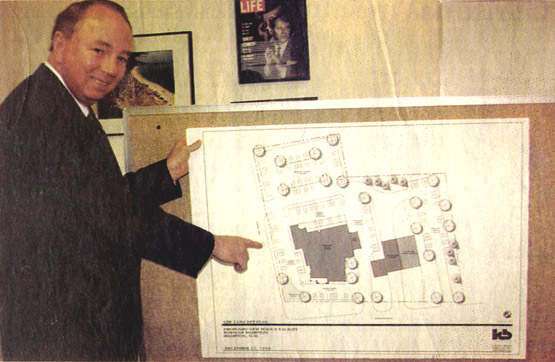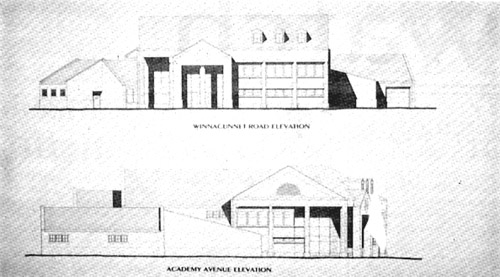By Tom Donaldson
Atlantic News, Thursday, December 31, 1998
[The following article is courtesy of the Atlantic News]

[Atlantic News Photo by Tom Donaldson]
HAMPTON — Chief William Wrenn and project architect Joseph Griffith of Kaestle Bros. Associates presented a finalized rendering of plans for the proposed police department building to the selectmen at their regular Monday night meeting. The new police department is to be built on the corner of Winnacunnet Road and Academy Avenue where the district courthouse and the present town building now stand. The construction proposal there includes moving the courthouse if its historic value can be determined, and may include demolition of the present town building. The revised plans had just been finalized on Monday prior to the meeting.
Wrenn pointed out that the building would not take any parking spaces or impede the entrance and exit of the school buses at the Hampton Academy Junior High School farther north on Academy Avenue. He said that there may be some suggestions to improve the flow of the daily school bus drop-off and pick-up of the students.
A bright, pleasant lobby with windows to take advantage of the southern exposure would face Winnacunnet and would be the reception area, with public rest rooms and access to the dispatcher’s window. From the lobby or an outside entrance, the public could enter a community room which Wrenn explained could be used by senior citizens, boy or girl scouts, and other similar groups. The community room and the lobby would be secure and non-accessible by any prisoners or suspects being detained or interviewed. There would be a small room off the lobby where the citizens could talk privately to a police officer.
The chief said that he and other officers had worked many hours with the architect on three points concerning the flow of activities in the new building for the public, the employees, and the prisoners using the building for parking, entrance and accessibility of personnel who would deal with their needs. Employees would park in the rear of the building with an entrance that would provide easy-flow to the officers’ squad room or stairs leading up to locker rooms, a fitness center and administrative offices.

[Atlantic News Photo by Tom Donaldson]
Prisoners being brought in would enter through a sally port located at the rear. A cruiser would enter the fully enclosed sally port after an officer requests that the garage type door be opened. The door would then be closed and locked so that the prisoner could be removed from the car and taken to a holding area and booking room, near the jail cells. The areas would be segregated for males, females and juveniles being brought in. The patrol sergeants’ and lieutenants’ offices would be in close proximity to monitor those activities. There would be a secure evidence room where officers could place evidence, weapons or drugs from outside the room into a locker which is open in to the evidence room so that the evidence officer could remove them and lock them up after his inventory. He said only an authorized evidence officer would be allowed in the room so that evidence would not be at risk for contamination.
Space in the rear would allow minor servicing of the police vehicles with oil and other fluids, or emergency cleaning from a sick or contaminated prisoner, duties which officers usually do themselves. The space would also provide an area for processing vehicles that might have been involved in a crime scene. There would be a temporary storage area for animals, an armory, and, a response team room where officers could be equipped for handling special emergencies.
The second floor would house the locker and fitness rooms with access to the administration area, where the chief and the captains would have offices. There is space for the administrative assistant and the secretary to the captains. Both a conference room for small meetings would be available as well as a room that could be set-up as a major crime room for detectives and the prosecutor who is also housed there.
The selectmen sat silently, sometimes smiling and nodding heads in apparent agreement over the plans which Wrenn called a “dynamite design.” No criticism was made about any of part of the plans, which will be on display for the public in the selectmen’s room. Selectman Bonnie Searle asked if the estimate was still over $5 million. Wrenn said that was correct; however, the cost of the building fully equipped would be $3.4 million. Intangible costs could possibly be further reduced depending on the disposition of the courthouse and the town buildings. There is $100,000 in his budget to move the courthouse. He stated that the costs had already been reduced and that the building was not an office building but a 24-hour turn-key facility that had been planned to take hard use and abuse.
Wrenn gave credit to captain Timothy Crotts, Steve Henderson (head of the patrolmen association), and other officers who had put forth many suggestions and much effort in the design. He cited the cooperation and extra efforts of project architect Joseph Griffith and the personnel at Kaestle Bros. Associates.